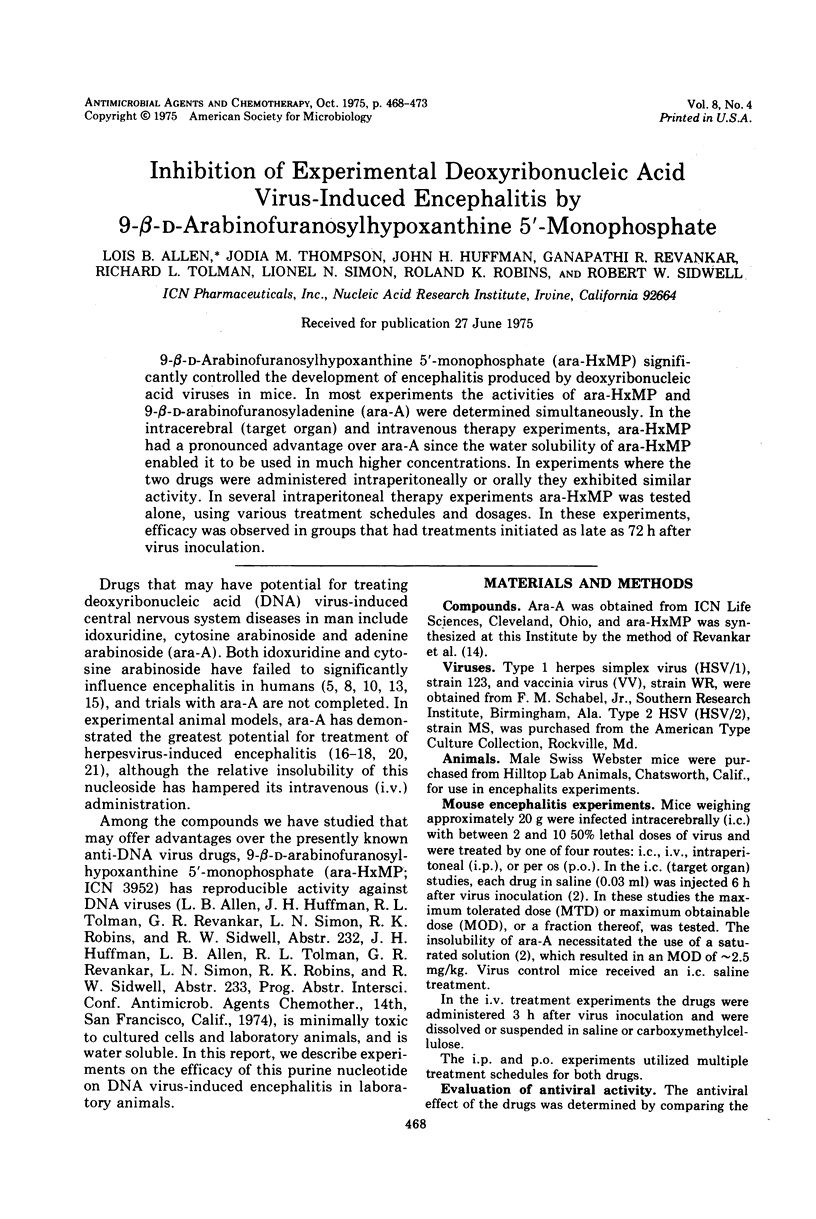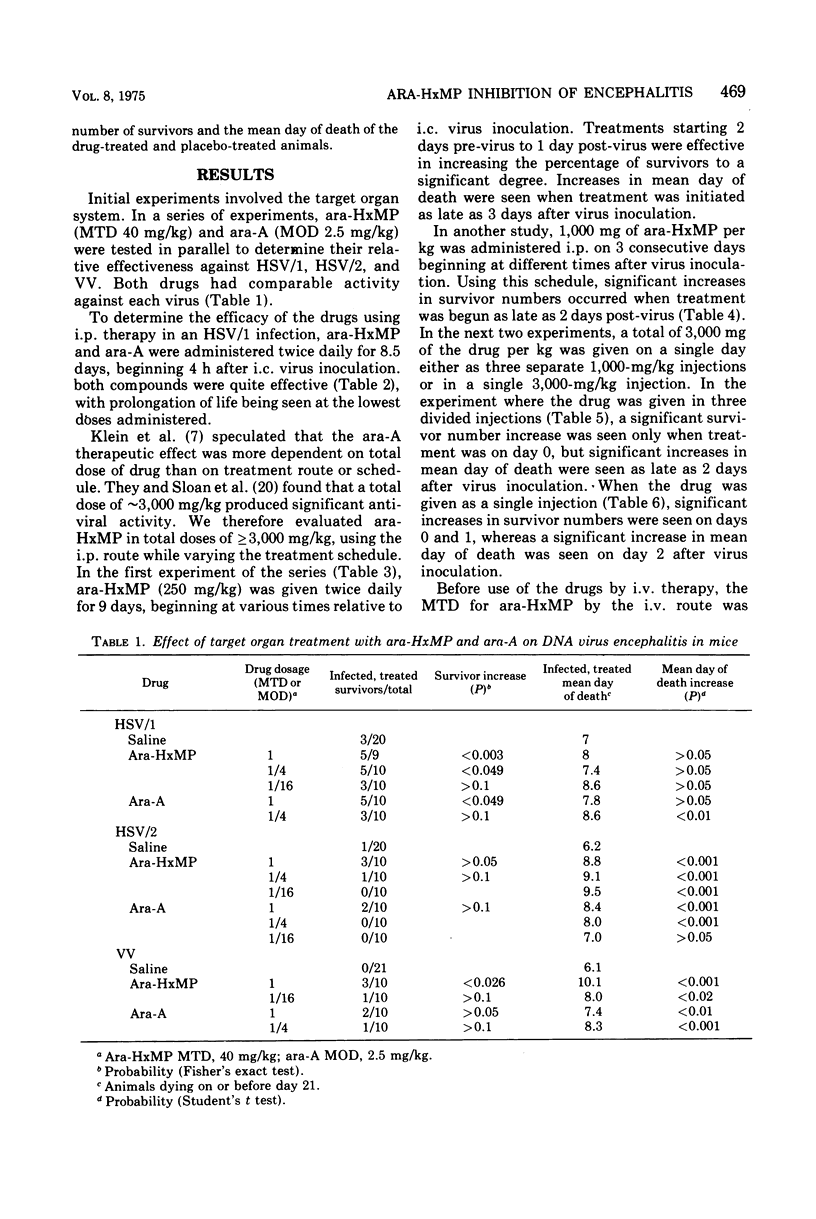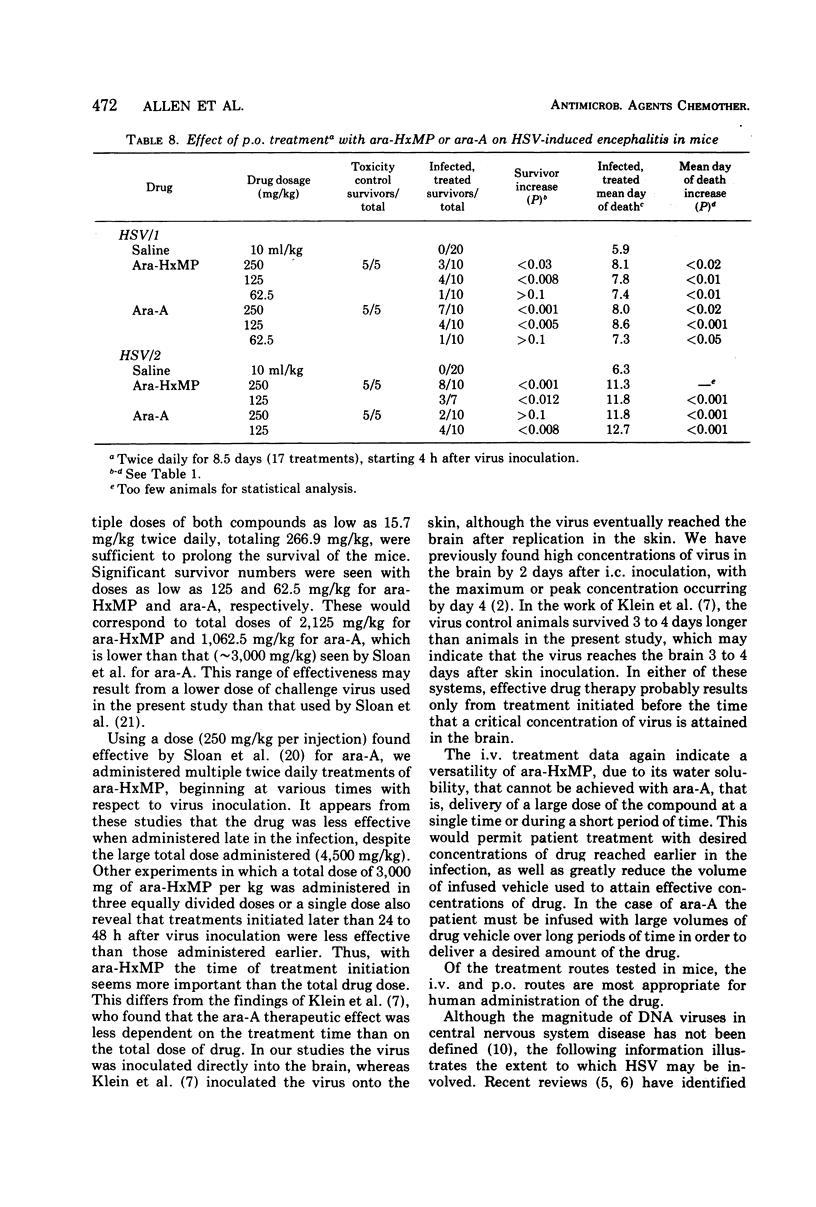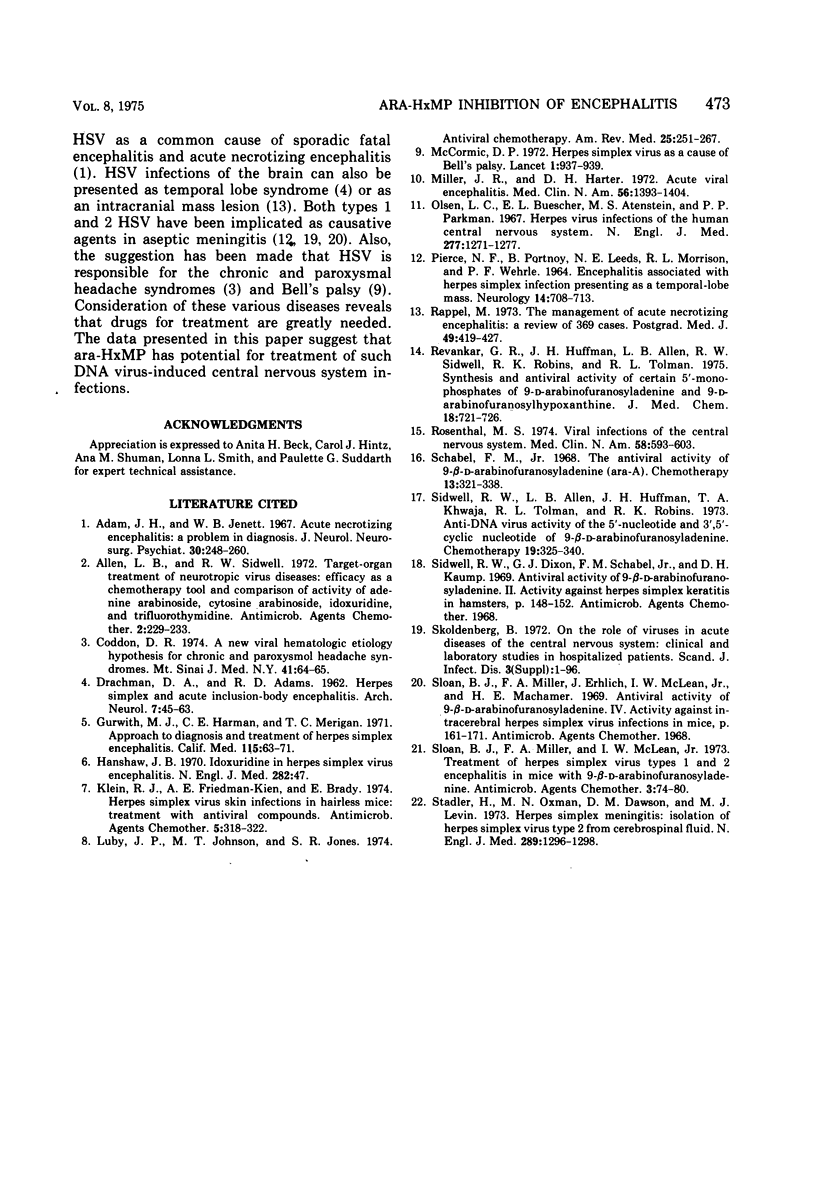Abstract
9-β-d-Arabinofuranosylhypoxanthine 5′-monophosphate (ara-HxMP) significantly controlled the development of encephalitis produced by deoxyribonucleic acid viruses in mice. In most experiments the activities of ara-HxMP and 9-β-d-arabinofuranosyladenine (ara-A) were determined simultaneously. In the intracerebral (target organ) and intravenous therapy experiments, ara-HxMP had a pronounced advantage over ara-A since the water solubility of ara-HxMP enabled it to be used in much higher concentrations. In experiments where the two drugs were administered intraperitoneally or orally they exhibited similar activity. In several intraperitoneal therapy experiments ara-HxMP was tested alone, using various treatment schedules and dosages. In these experiments, efficacy was observed in groups that had treatments initiated as late as 72 h after virus inoculation.
Full text
PDF





Selected References
These references are in PubMed. This may not be the complete list of references from this article.
- Adams J. H., Jennett W. B. Acute necrotizing encephalitis: a problem in diagnosis. J Neurol Neurosurg Psychiatry. 1967 Jun;30(3):248–260. doi: 10.1136/jnnp.30.3.248. [DOI] [PMC free article] [PubMed] [Google Scholar]
- Allen L. B., Sidwell R. W. Target-organ treatment of neurotropic virus diseases: efficacy as a chemotherapy tool and comparison of activity of adenine arabinoside, cytosine arabinoside, idoxuridine, and trifluorothymidine. Antimicrob Agents Chemother. 1972 Sep;2(3):229–233. doi: 10.1128/aac.2.3.229. [DOI] [PMC free article] [PubMed] [Google Scholar]
- Coddon D. R. A new viral-hematologic etiology hypothesis for chronic and paroxysmal headache syndromes. Mt Sinai J Med. 1974 Jan-Feb;41(1):64–65. [PubMed] [Google Scholar]
- DRACHMAN D. A., ADAMS R. D. Herpes simplex and acute inclusion-body encephalitis. Arch Neurol. 1962 Jul;7:45–63. doi: 10.1001/archneur.1962.04210010051005. [DOI] [PubMed] [Google Scholar]
- Gurwith M. J., Harman C. E., Merigan T. C. Approach to diagnosis and treatment of herpes simplex encephalitis. A report of two cases. Calif Med. 1971 Dec;115(6):63–71. [PMC free article] [PubMed] [Google Scholar]
- Hanshaw J. R. Idoxuridine in herpesvirus encephalitis. N Engl J Med. 1970 Jan 1;282(1):47–47. doi: 10.1056/NEJM197001012820113. [DOI] [PubMed] [Google Scholar]
- Klein R. J., Friedman-Kien A. E., Brady E. Herpes simplex virus skin infection in hairless mice: treatment with antiviral compounds. Antimicrob Agents Chemother. 1974 Mar;5(3):318–322. doi: 10.1128/aac.5.3.318. [DOI] [PMC free article] [PubMed] [Google Scholar]
- Luby J. P., Johnson M. T., Jones S. R. Antiviral chemotherapy. Annu Rev Med. 1974;25:251–267. doi: 10.1146/annurev.me.25.020174.001343. [DOI] [PubMed] [Google Scholar]
- McCormick D. P. Herpes-simplex virus as a cause of Bell's palsy. Lancet. 1972 Apr 29;1(7757):937–939. doi: 10.1016/s0140-6736(72)91499-7. [DOI] [PubMed] [Google Scholar]
- Miller J. R., Harter D. H. Acute viral encephalitis. Med Clin North Am. 1972 Nov;56(6):1393–1404. doi: 10.1016/s0025-7125(16)32328-8. [DOI] [PubMed] [Google Scholar]
- Olson L. C., Buescher E. L., Artenstein M. S., Parkman P. D. Herpesvirus infections of the human central nervous system. N Engl J Med. 1967 Dec 14;277(24):1271–1277. doi: 10.1056/NEJM196712142772401. [DOI] [PubMed] [Google Scholar]
- PIERCE N. F., LEEDS N. R., PORTNOY B., MORRISON R. L., WEHRLE P. F. ENCEPHALITIS ASSOCIATED WITH HERPES SIMPLEX INFECTION PRESENTING AS A TEMPORAL-LOBE MASS: REPORT OF 2 CASES WITH SURVIVAL. Neurology. 1964 Aug;14:708–713. doi: 10.1212/wnl.14.8_part_1.708. [DOI] [PubMed] [Google Scholar]
- Revankar G. R., Huffman J. H., Allen L. B., Sidwell R. W., Robins R. K., Tolman R. L. Synthesis and antiviral activity of certain 5'-monophosphates of 9-D-arabinofuranosyladenine and 9-D-arabinofuranosylhypoxanthine. J Med Chem. 1975 Jul;18(7):721–726. doi: 10.1021/jm00241a016. [DOI] [PubMed] [Google Scholar]
- Rosenthal M. S. Viral infections of the central nervous system. Med Clin North Am. 1974 May;58(3):593–603. doi: 10.1016/s0025-7125(16)32146-0. [DOI] [PubMed] [Google Scholar]
- Schabel F. M., Jr The antiviral activity of 9-beta-D-arabinofuranosyladenine (ARA-A). Chemotherapy. 1968;13(6):321–338. doi: 10.1159/000220567. [DOI] [PubMed] [Google Scholar]
- Sidwell R. W., Allen L. B., Huffman J. H., Khwaja T. A., Tolman R. L., Robins R. K. Anti-DNA virus activity of the 5'-nucleotide and 3',5'-cyclic nucleotide of 9-beta-D-arabinofuranosyladenine. Chemotherapy. 1973;19(6):325–340. doi: 10.1159/000221473. [DOI] [PubMed] [Google Scholar]
- Sköldenberg B. On the role of viruses in acute infectious diseases of the central nervous system. Clinical and laboratory studies on hospitalized patients. Scand J Infect Dis. 1972;3(Suppl):1–96. doi: 10.3109/inf.1972.4.suppl-3.01. [DOI] [PubMed] [Google Scholar]
- Sloan B. J., Miller F. A., McLean I. W., Jr Treatment of herpes simplex virus types 1 and 2 encephalitis in mice with 9-beta-D-arabinofuranosyladenine. Antimicrob Agents Chemother. 1973 Jan;3(1):74–80. doi: 10.1128/aac.3.1.74. [DOI] [PMC free article] [PubMed] [Google Scholar]
- Stalder H., Oxman M. N., Dawson D. M., Levin M. J. Herpes simplex meningitis: isolation of herpes simplex virus type 2 from cerebrospinal fluid. N Engl J Med. 1973 Dec 13;289(24):1296–1298. doi: 10.1056/NEJM197312132892409. [DOI] [PubMed] [Google Scholar]


